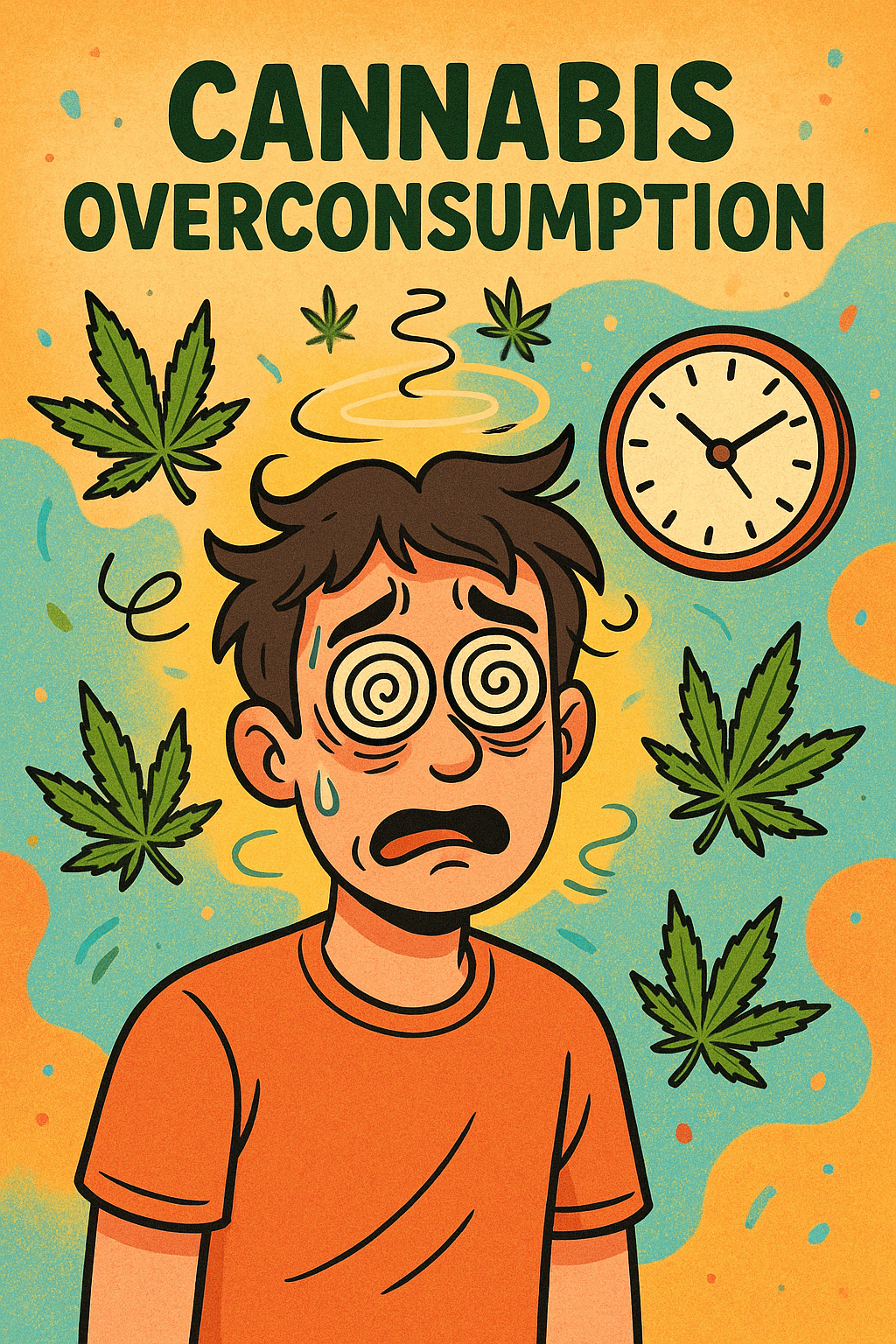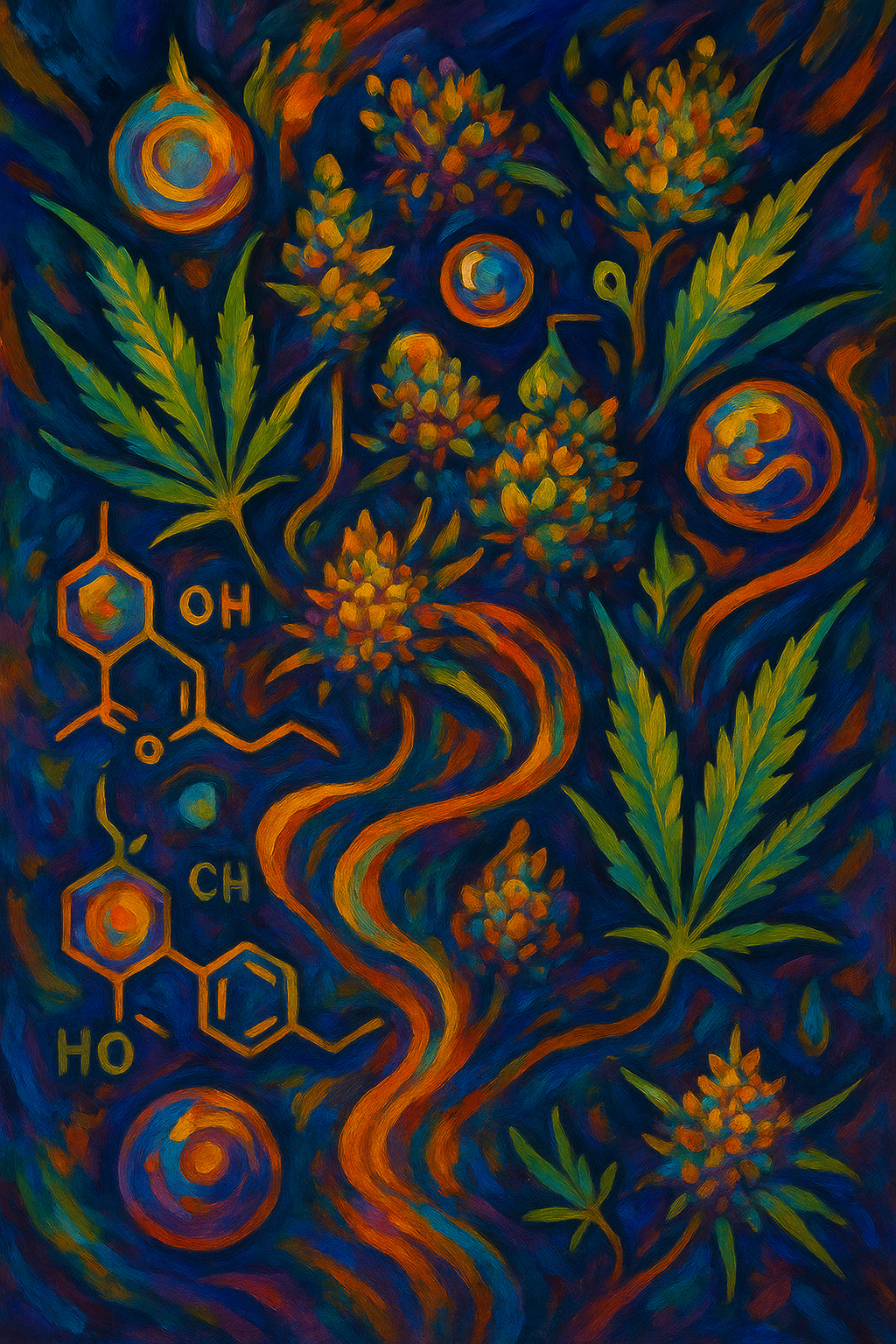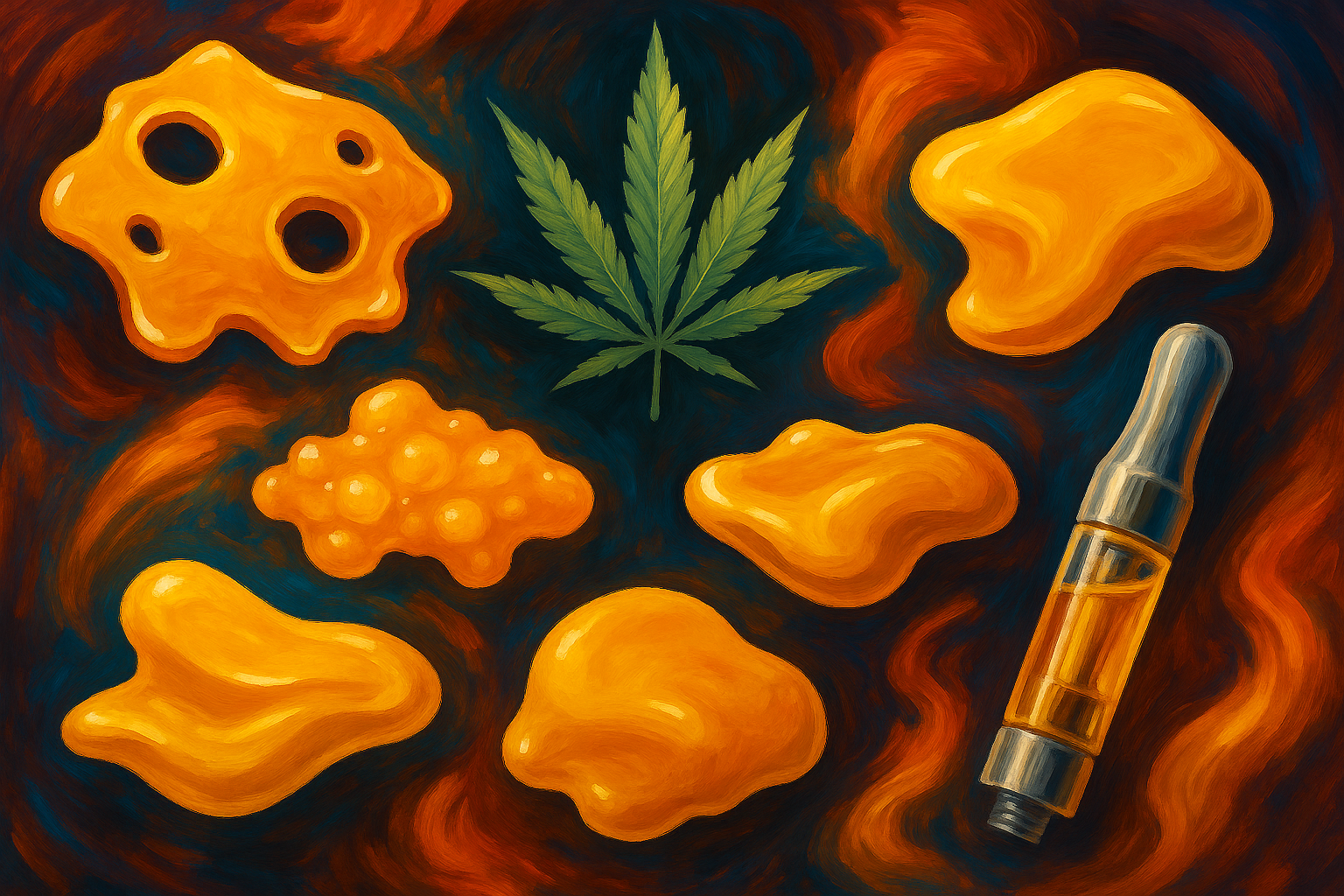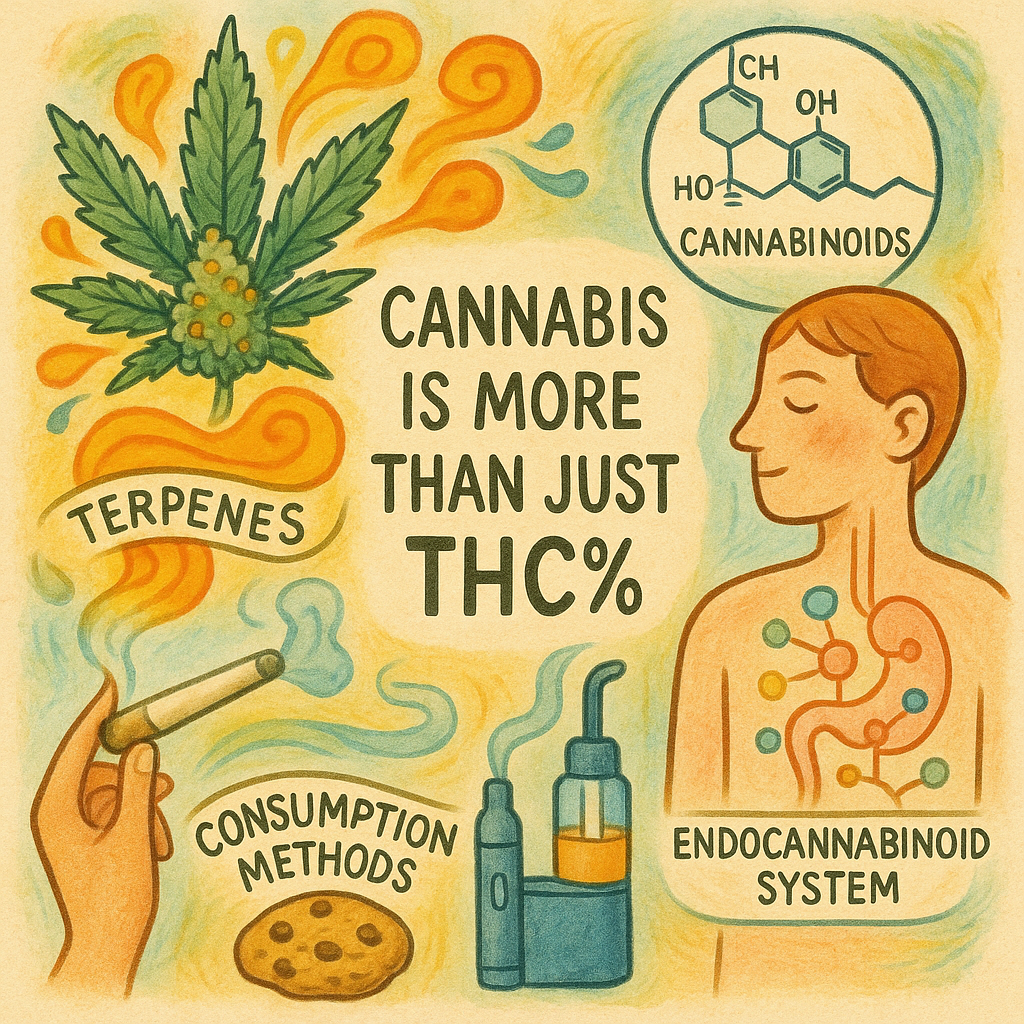Cannabis overconsumption, commonly known as "greening out," affects millions of users who find themselves feeling uncomfortably high and seeking ways to reduce their intoxication[1][2]. While cannabis cannot cause a fatal overdose, consuming too much can lead to anxiety, paranoia, nausea, and other distressing symptoms that require immediate management[3][4]. This comprehensive guide provides evidence-based strategies, natural remedies, and safety protocols to help individuals navigate cannabis overconsumption safely and effectively.
The Roach
A 5-minute quick hit of essential information
What is Cannabis Overconsumption?
Cannabis overconsumption occurs when someone consumes more THC than their body can comfortably handle, leading to uncomfortable symptoms like anxiety, paranoia, nausea, dizziness, and confusion[5][6][7]. Unlike alcohol or opioid overdoses, cannabis overconsumption is not life-threatening but can be extremely distressing[4].
Immediate Action Steps:
The most crucial first step is to remain calm and remember that the effects are temporary[1][8][9]. Find a safe, comfortable environment away from crowds and practice deep breathing techniques[10][11]. Stay hydrated by sipping water slowly, but avoid alcohol completely as it can worsen symptoms[2][9][12].
Person in a meditative pose demonstrating a relaxation technique on a yoga mat.
Natural Remedies That May Help:
Two popular home remedies show promise: black pepper and citrus fruits [8][13][14]. Sniffing ground black pepper or chewing 2-3 whole peppercorns may provide relief due to beta-caryophyllene, a compound that interacts with cannabinoid receptors[8][15][16]. Similarly, lemon's limonene terpene may counteract THC's anxiety-inducing effects[1][14][17].
Whole black peppercorns in a bowl, often suggested as a natural remedy for cannabis effects.
A bowl of fresh lemons on a kitchen counter, illustrating citrus fruits that may help alleviate cannabis-induced discomfort.
Timeline Expectations:
Effects duration varies significantly by consumption method [18][19][20]. Smoking or vaping typically lasts 1-4 hours, while edibles can persist for 4-8+ hours or longer[21][18][19]. Understanding these timelines helps manage expectations and reduce panic.
Timeline showing how long cannabis effects last based on different consumption methods
When to Seek Medical Help:
While most symptoms are manageable at home, seek immediate medical attention for severe panic attacks, chest pain, difficulty breathing, persistent vomiting, loss of consciousness, or hallucinations [22][23][6]. Medical professionals cannot get you in legal trouble for seeking help[22].
Prevention is Key:
The best strategy is prevention through responsible use: start with low doses, especially with edibles, understand your tolerance, avoid mixing substances, and use in safe environments with trusted people[11][24][25].
The Weekly Dab
Complete comprehensive cannabis overconsumption education
Understanding Cannabis Overconsumption
Cannabis overconsumption represents a significant public health concern as legalization expands access and THC potency continues to increase[26]. Modern cannabis products can contain THC levels exceeding 20-30%, compared to less than 4% in the 1990s[26]. This dramatic increase in potency, combined with the availability of concentrates and high-dose edibles, has led to more frequent overconsumption incidents requiring emergency care[22][23].
The term "greening out" describes the uncomfortable experience of consuming too much cannabis, characterized by a range of physical and psychological symptoms[6][7]. Unlike alcohol poisoning or opioid overdoses, cannabis overconsumption cannot directly cause death, but it can create extremely distressing experiences that may require medical intervention[3][27][4].
Immediate Management Strategies
When someone experiences cannabis overconsumption, the initial response determines the outcome's severity and duration[1][8][9]. The fundamental principle is maintaining calm while implementing evidence-based interventions that address both physical and psychological symptoms.
Primary Stabilization Techniques
The first priority involves establishing psychological stability through breathing exercises and environmental management[1][10]. Deep breathing activates the parasympathetic nervous system, reducing anxiety and panic responses that often exacerbate overconsumption symptoms[10]. The 5-4-3-2-1 grounding technique—identifying five things you can see, four you can hear, three you can touch, two you can smell, and one you can taste—helps anchor individuals in the present moment and reduce dissociation[1].
A group practices meditation outdoors, illustrating deep breathing and relaxation techniques.
Creating a safe physical environment is equally crucial [5][28]. This involves moving to a comfortable, familiar space away from crowds, loud noises, or other stimuli that might intensify anxiety[9][12][5]. The environment should promote relaxation and safety, allowing the individual to rest without external stressors.
A cozy living room with a dark grey tufted sofa and armchairs, creating a comfortable and secure environment.
Hydration and Basic Care
Proper hydration addresses one of the most common and uncomfortable symptoms of cannabis use: dry mouth or cottonmouth[1][2]. Cannabis affects saliva production, and dehydration can worsen overall discomfort[1]. However, hydration should be gradual—sipping water slowly rather than consuming large quantities at once[2][29].
Woman drinking water from a blue bottle against a bright sky, illustrating the importance of hydration.
Avoiding alcohol is critical during cannabis overconsumption [2][9][12]. Alcohol can potentiate THC effects, worsen coordination, and increase the risk of dangerous behaviors like driving under the influence[2]. Additionally, the combination may increase nausea and other uncomfortable symptoms.
Natural Remedies and Interventions
Several natural compounds show promise in mitigating cannabis overconsumption symptoms, though scientific evidence varies in quality and consistency[1][8][13].
Black Pepper Method
Black pepper contains beta-caryophyllene, a terpene that acts as a selective CB2 receptor agonist[8][15][16]. This compound may help modulate the endocannabinoid system and potentially reduce anxiety associated with THC overconsumption[15][16]. Users report relief from sniffing ground black pepper or chewing 2-3 whole peppercorns[8][13]. While anecdotal evidence is strong, controlled clinical studies specifically examining black pepper's effectiveness for cannabis overconsumption remain limited[15].
A variety of peppercorns, including green, red, black, and white, arranged on a white surface.
Citrus and Limonene
Limonene, the primary terpene in citrus fruits, particularly lemons, shows promise in counteracting THC-induced anxiety[14][17]. Recent research suggests that limonene may interact with neurotransmitter systems to reduce paranoia and anxiety associated with cannabis use[14]. Historical accounts dating back to the 10th century describe Persian physicians using lemon as an antidote to cannabis intoxication[1]. Modern applications include zesting lemon peel in hot water, drinking lemon water, or simply smelling fresh citrus[1][17].
CBD as a Potential Antagonist
Cannabidiol (CBD) has been proposed as a potential remedy for THC overconsumption, though research results are mixed[30][31][32][33]. Some studies suggest CBD may counteract THC's psychoactive effects by acting as a negative allosteric modulator at CB1 receptors[32][34]. However, more recent research indicates that CBD's ability to mitigate THC effects may be more complex than previously understood[31][35][33].
A 2023 Johns Hopkins study found that in edible cannabis products, CBD actually increased THC blood levels and prolonged effects, contrary to the expected protective effect[35]. This finding highlights the importance of understanding that CBD's interaction with THC varies depending on the consumption method and individual factors[35][33].
Timeline and Duration Management
Understanding cannabis effects timelines is crucial for managing overconsumption episodes effectively[21][18][19][20]. The onset, peak, and duration of effects vary dramatically based on consumption method, individual metabolism, tolerance, and product potency.
Smoking and Vaping
Inhaled cannabis produces rapid onset effects, typically beginning within 2-10 minutes of consumption[18][19]. Peak effects occur within 30-60 minutes, with total duration ranging from 1-4 hours[21][18][20]. This relatively short timeline can provide reassurance to individuals experiencing uncomfortable symptoms, as they can expect significant improvement within hours.
Edibles and Oral Consumption
Edibles present unique challenges due to their delayed onset and prolonged duration[21][18][19][25]. Effects may not appear for 30 minutes to 2 hours after consumption, leading some users to consume additional doses before feeling initial effects[25][36]. When effects do manifest, they can be more intense and longer-lasting than inhaled cannabis, potentially persisting for 4-8 hours or longer[21][18][19].
The delayed onset of edibles contributes significantly to overconsumption incidents[25][36]. Users often consume additional doses during the onset period, resulting in cumulative effects that exceed intended levels[25]. This phenomenon underscores the importance of the "start low, go slow" approach with edible products.
Concentrates and Dabbing
Cannabis concentrates, including "dabs," typically produce immediate effects with high intensity[18][20]. The onset is nearly instantaneous, peak effects occur within 30 minutes, and duration ranges from 1-3 hours[20]. Due to the high THC concentration in these products, overconsumption incidents can be severe and may require more intensive management[20].
Distraction and Coping Strategies
Effective distraction techniques help redirect attention away from uncomfortable sensations while promoting relaxation and recovery[1][2][8]. These strategies should be simple, engaging, and appropriate for the individual's current level of impairment.
Physical Activities
Light physical activity can help improve circulation, release endorphins, and provide mental distraction[1][12]. Suitable activities include gentle walking (if balance allows), light stretching, or taking a shower[1][12]. The choice of activity should consider the individual's current coordination and safety[10].
Mental and Creative Distractions
Engaging the mind with simple, enjoyable activities can effectively reduce focus on uncomfortable symptoms[1][2][8]. Options include watching familiar, comforting television shows or movies, listening to calming music, playing simple games, or engaging in creative activities like drawing or crafts[1][2]. The key is selecting activities that feel manageable and enjoyable rather than challenging or stressful.
Social Support
Having a trusted friend or family member present provides emotional support and practical assistance[2][9][10]. Social support helps reduce isolation, provides reality checks during anxiety episodes, and ensures someone can seek help if symptoms worsen[10]. The support person should remain calm, reassuring, and avoid making the situation more stressful.
Medical Considerations and Emergency Protocols
While cannabis overconsumption rarely requires emergency medical intervention, certain symptoms warrant immediate professional attention[22][23][6]. Understanding the difference between manageable symptoms and medical emergencies is crucial for appropriate response.
Manageable Symptoms
Most cannabis overconsumption symptoms can be managed safely at home with supportive care[1][2][6]. These include mild to moderate anxiety, paranoia, confusion, dry mouth, dizziness, increased appetite, and feeling generally overwhelmed or "too high"[6][7]. These symptoms, while uncomfortable, typically resolve within hours as THC metabolizes[21][18][19].
Emergency Warning Signs
Certain symptoms require immediate medical evaluation and potential emergency intervention[22][23][6]. These include severe panic attacks that don't respond to calming techniques, chest pain or irregular heart palpitations, difficulty breathing, persistent severe vomiting leading to dehydration, loss of consciousness, vivid hallucinations, or signs of psychosis such as extreme paranoia or detachment from reality[22][6].
Emergency department visits related to cannabis use have increased significantly, particularly among young people[23]. Healthcare providers are equipped to manage cannabis overconsumption with supportive care, hydration, and symptom management[22]. Importantly, seeking medical help for cannabis-related issues does not result in legal consequences for the patient[22].
Harm Reduction and Prevention Strategies
Preventing cannabis overconsumption through education and harm reduction strategies represents the most effective approach to managing this issue[11][37][24]. Evidence-based prevention focuses on responsible use practices, product knowledge, and environmental considerations.
Dosing Guidelines
The fundamental principle of cannabis harm reduction is "start low, go slow," particularly with edibles and unfamiliar products[11][24][25]. New users should begin with the lowest possible dose (2.5-5mg THC for edibles) and wait at least 2 hours before considering additional consumption[36]. Experienced users should respect their established tolerance levels and avoid dramatically increasing doses.
Product Awareness
Understanding THC content and product types helps users make informed decisions about consumption[11][26]. Modern cannabis products vary dramatically in potency, with some containing 20-30% THC or higher[26]. Concentrates can exceed 80-90% THC, requiring extreme caution and experience[20]. Users should always verify product information and choose appropriate products for their experience level and intended effects.
Environmental and Social Factors
Safe use environments contribute significantly to positive cannabis experiences and reduced overconsumption risk[11][24][28]. Ideal settings include familiar, comfortable locations with trusted companions who can provide support if needed[11][28]. Avoiding high-stress situations, unfamiliar environments, or mixing cannabis with alcohol or other substances reduces complications[11][24].
A bright and inviting living room with comfortable seating and natural elements, creating a cozy and tranquil atmosphere.
Scientific Understanding and Future Directions
Current research into cannabis overconsumption management continues to evolve, with particular interest in terpene interactions, CBD's role, and individual factors that influence THC sensitivity[30][31][13][14]. The entourage effect—the theory that cannabis compounds work synergistically—may explain why certain natural remedies show promise in managing overconsumption symptoms[13][38].
Terpene Research
Scientific investigation into terpenes like limonene and beta-caryophyllene provides insight into potential therapeutic applications beyond cannabis[16][14][38]. These compounds interact with various neurotransmitter systems and may offer novel approaches to managing anxiety and other conditions[16][14][38].
Individual Variation
Research increasingly recognizes that cannabis effects vary significantly between individuals due to genetic factors, metabolism, tolerance, and psychological state[39][19][40]. This variability explains why standardized dosing recommendations may not work for everyone and why personalized approaches to cannabis use are necessary[40].
Educational and Policy Implications
As cannabis legalization expands, comprehensive education about overconsumption management becomes increasingly important[41]. Effective cannabis education programs emphasize evidence-based information, harm reduction principles, and practical skills for safe use[41]. These programs should be accessible to diverse populations and updated regularly to reflect evolving research and product availability[41].
Healthcare Provider Training
Healthcare providers require education about cannabis overconsumption to provide appropriate care without judgment[22][26]. Training should cover symptom recognition, supportive care protocols, and when to escalate to emergency intervention[22]. Providers should understand that cannabis-related medical visits often involve anxiety management rather than toxicological emergencies.
Public Health Messaging
Effective public health messaging about cannabis overconsumption should balance honest discussion of risks with practical harm reduction information[11][41]. Messages should avoid fear-based approaches while providing concrete strategies for preventing and managing overconsumption[41].
Conclusion
Cannabis overconsumption, while not life-threatening, can create significant distress requiring immediate and appropriate intervention[1][6][4]. Effective management combines psychological stabilization, supportive care, natural remedies with emerging scientific support, and appropriate medical evaluation when necessary[1][8][13]. The most effective approach remains prevention through education, responsible use practices, and harm reduction strategies[11][24][41].
Understanding that cannabis effects are temporary and manageable helps reduce panic and improves outcomes during overconsumption episodes[1][2]. With proper knowledge, preparation, and support systems, individuals can navigate these experiences safely while minimizing long-term negative consequences[11][24]. As cannabis use continues to increase, comprehensive education and accessible resources for overconsumption management become essential components of public health and safety[23][41].
| Remedy | How to Use | Science Behind It | Effectiveness |
| Stay Calm & Breathe | Deep breathing, meditation, remind yourself it will pass | Calms nervous system, reduces panic response | High - Essential first step |
| Hydrate | Drink water, herbal tea, or electrolyte drinks slowly | Reduces dry mouth, maintains bodily functions | High - Addresses common symptom |
| Find a Safe Space | Go to a comfortable, familiar environment away from crowds | Reduces external stressors and anxiety triggers | High - Reduces anxiety triggers |
| Distract Yourself | Watch TV, listen to music, play games, do light activities | Redirects focus away from uncomfortable sensations | Moderate to High - Varies by person |
| Black Pepper (Sniff/Chew) | Sniff ground pepper or chew 2-3 whole peppercorns | Contains beta-caryophyllene which may interact with CB2 receptors | Moderate - Anecdotal, limited science |
| Lemon/Citrus | Zest lemon peel in hot water, smell citrus, or drink lemon water | Limonene terpene may reduce anxiety and paranoia | Moderate - Emerging research support |
| CBD (if available) | Take CBD oil, gummies, or vape - may counteract THC effects | May block THC at cannabinoid receptors, reducing intoxication | Moderate - Mixed research results |
| Light Exercise/Walk | Take a gentle walk outdoors or do light stretching | Improves circulation, releases endorphins, provides distraction | Moderate - If not too impaired |
| Take a Shower | Take a warm or cool shower to refresh and reset | Physical reset can help mentally reset, temperature shock | Moderate - Provides mental reset |
| Call a Friend | Talk to someone you trust for support and perspective | Social support reduces isolation and provides reality check | High - Social support is crucial |
| Try to Sleep | Rest or nap if possible - time is the best remedy | Time allows THC to metabolize and clear from system | High - Time is the ultimate remedy |
| Avoid Alcohol | Alcohol can worsen effects and increase impairment | Prevents compounding impairment and dangerous interactions | High - Prevents worsening situation |
The evidence demonstrates that while cannabis overconsumption can be extremely uncomfortable, it is manageable with appropriate knowledge, preparation, and response strategies. Time remains the ultimate remedy, but evidence-based interventions can significantly improve comfort and safety during these episodes[1][2][21]. Through continued research, education, and harm reduction approaches, we can better support individuals who experience cannabis overconsumption while promoting safer and more informed use practices overall.






Leave a comment (all fields required)